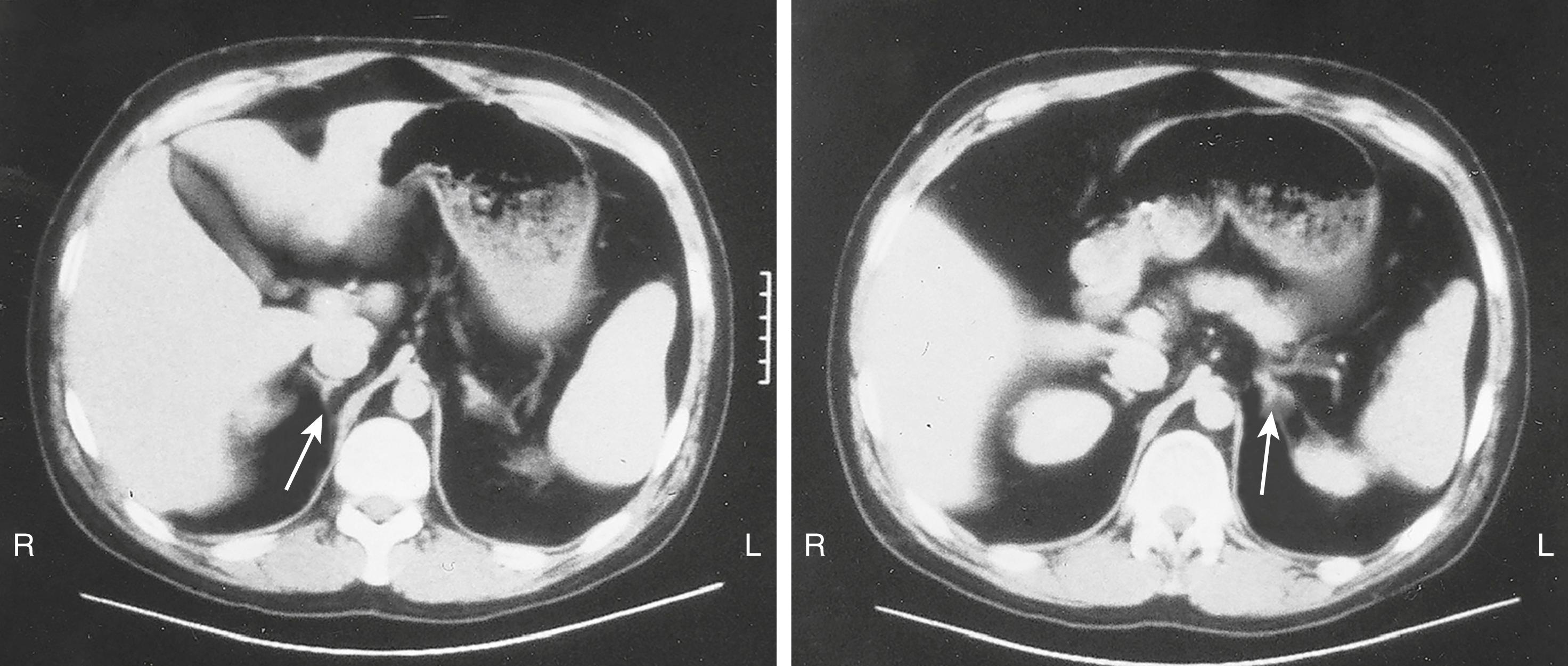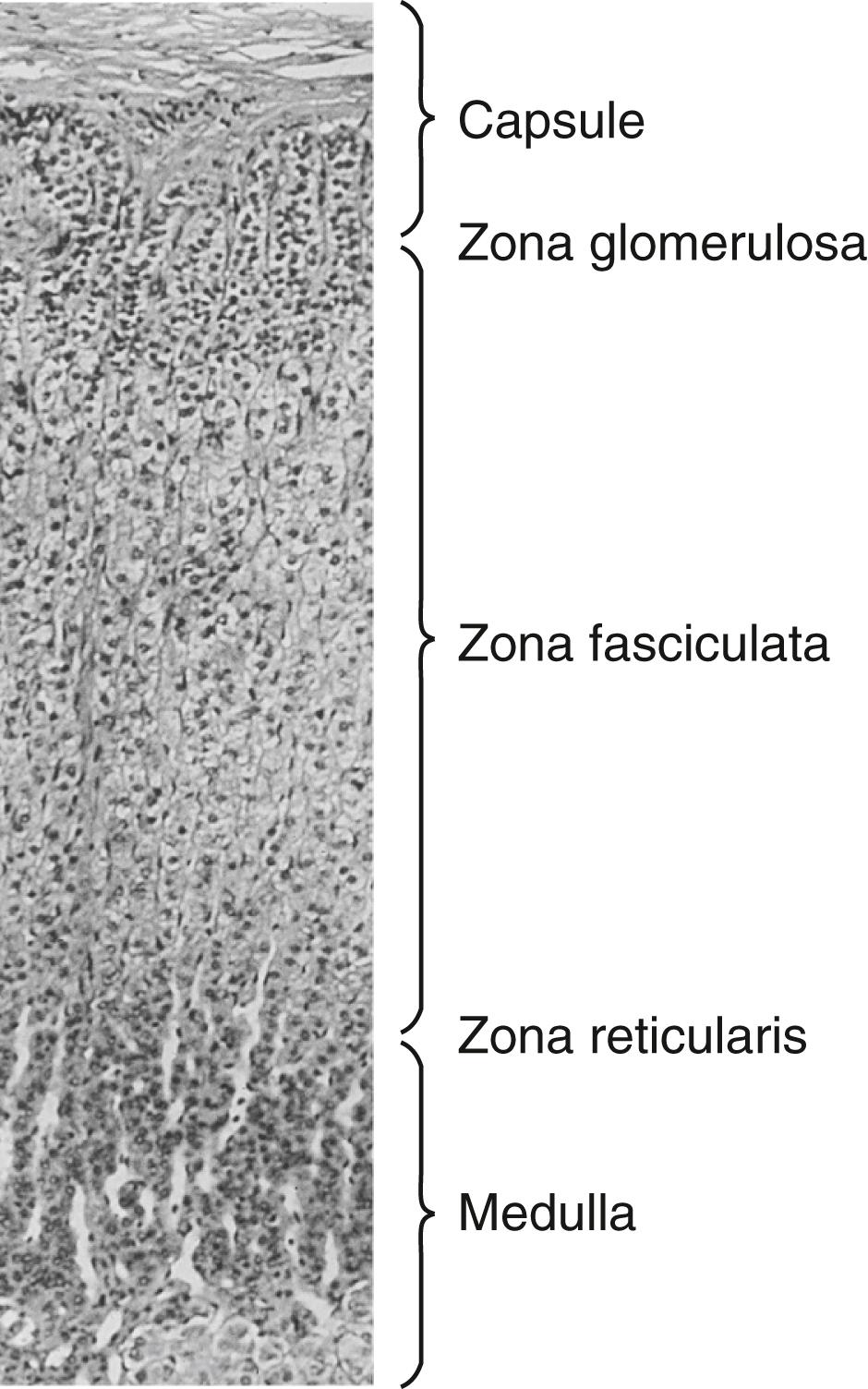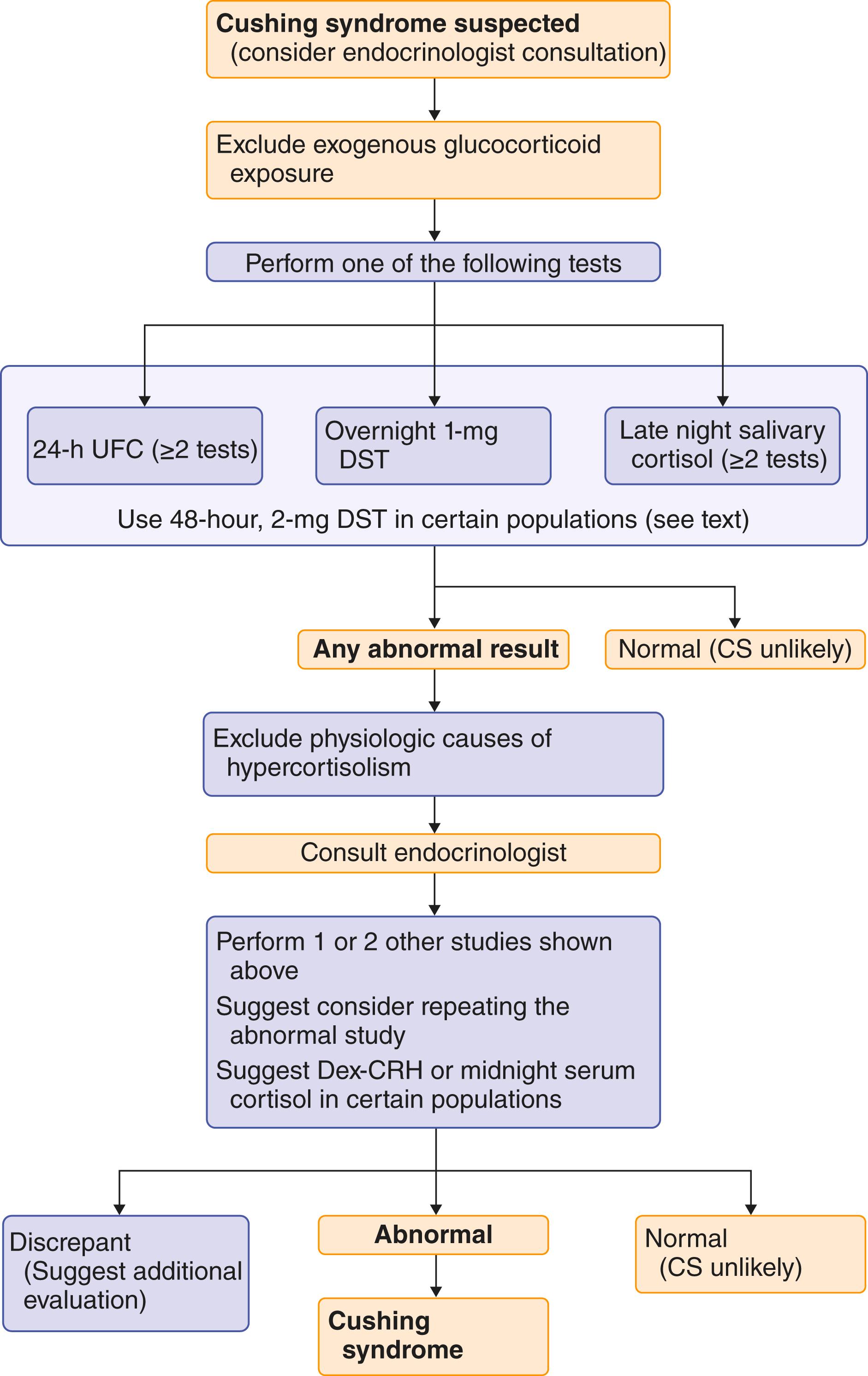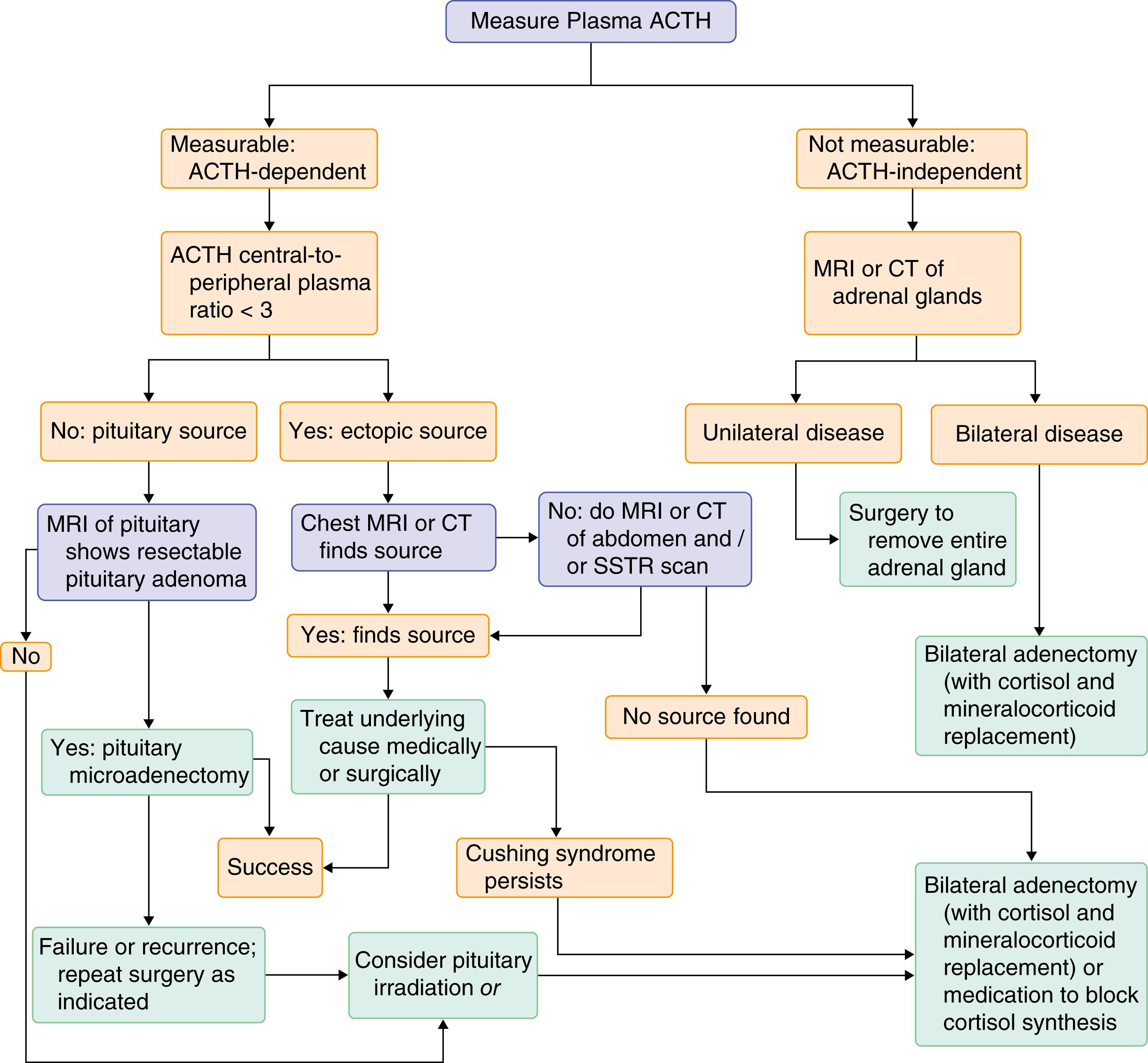Physical Address
304 North Cardinal St.
Dorchester Center, MA 02124
The adrenal glands weigh 6 to 8 g in adults ( Fig. 208-1 ). Each contains a cortex, which makes steroid hormones, and a medulla, which produces catecholamines. Diseases of the adrenal medulla are discussed in Chapter 209 . In the adrenal cortex, production of the three major classes of steroids occurs in specific zones: (1) the outermost layer, which is the glomerulosa, produces mineralocorticoids, primarily aldosterone; (2) the middle layer, which is the fasciculata, produces glucocorticoids, primarily cortisol; and (3) which is the innermost layer, the reticularis, produces adrenal androgens, primarily dehydroepiandrosterone (DHEA) and its sulfated conjugate (DHEA-S) ( Fig. 208-2 ). This division reflects the fact that certain critical enzymes are restricted to specific zones, thereby resulting in the ability or inability to synthesize specific end products.


The actions and regulation of these steroid classes differ. Mineralocorticoids act through the renal mineralocorticoid receptor to promote the reabsorption of sodium and the secretion of potassium. In addition to this classic action, mineralocorticoids have important action on the vasculature and may exacerbate the metabolic syndrome. The secretion of aldosterone is stimulated primarily by hyperkalemia and angiotensin II (which itself is stimulated by hypovolemia and excess renin). These agents increase the production of aldosterone synthase to restore homeostasis through this feedback loop. Aldosterone production is stimulated to a much smaller degree by adrenocorticotropic hormone (ACTH).
Cortisol and other glucocorticoids act through the glucocorticoid receptor type 2 and its isoforms. The actions of this class of steroids are much broader, including effects on carbohydrate handling, lipid and calcium metabolism, and the immune and nervous systems. Cortisol production is regulated primarily by pituitary ACTH ( Chapter 205 ), which is secreted in a circadian rhythm in response to hypothalamic corticotropin-releasing hormone (CRH; Chapter 204 ) so that cortisol levels are highest in the morning and fall to a nadir around midnight. Cortisol coordinates the production of ACTH through negative feedback at the pituitary (ACTH) and hypothalamus (CRH). Vasopressin secretion also plays a role in stimulating ACTH release.
DHEA and DHEA-S, which are the most abundant products of the adrenal gland, exert their estrogenic and androgenic effects as prohormones after being converted to estrogens and testosterone in the peripheral tissues, where they activate the androgen and estrogen receptors. There is no known regulator of DHEA synthesis, but its production declines with age.
The annual incidence of Cushing syndrome is estimated to be between 1.8 and 3.2 cases/million. It is more common in women than in men (6 : 1 ratio), with a mean age at onset in the fourth decade.
Most disorders of the adrenal cortex reflect overproduction or underproduction of the products of a single synthetic zone—cortisol, aldosterone, or testosterone or estrogen ( Fig. 208-3 ). The congenital adrenal hyperplasias, which are an exception, manifest with both overproduction and underproduction. Abnormal secretion is suggested by clinical features of each disorder and is reflected in plasma or urine levels of the relevant hormones or by the consequent increases or decreases in feedback systems, which form the basis of the biochemical diagnostic tests.

In Cushing syndrome, higher brain pathways stimulate the release of CRH and activation of the entire hypothalamic-pituitary-adrenal axis (see Fig. 208-3E ). Cortisol negative feedback inhibition on CRH and pituitary ACTH release restrains the resulting hypercortisoluria to less than four-fold greater than normal.
In Carney syndrome, in which hyperfunctioning adrenal nodules cause Cushing syndrome, myxomas, and spotty skin pigmentation, patients have mutations that lead to a truncated form of protein kinase A regulatory 1α subunit. The resultant increase in protein kinase A activation by cyclic adenosine monophosphate presumably allows tumor formation. In bilateral macronodular adrenal hyperplasia, aberrant expression of “illicit” receptors for various ligands (gastric inhibitory polypeptide, β-adrenergic, vasopressin) presumably mediates autonomous cortisol production.
Cushing syndrome is a symptom complex that reflects excessive exposure of tissues to cortisol. Classic features of Cushing syndrome include weight gain, plethora, hypertension, and striae ( Table 208-1 ). Not all patients have all features; the number and severity of features correlate roughly with the duration and severity of hypercortisolism. Changes in mood and cognition include irritability, crying, and restlessness; depressed mood; decreased libido; insomnia; anxiety; and decreased concentration and impaired memory.
| SIGN OR SYMPTOM | PERCENTAGE |
|---|---|
| Decreased libido in men and women | 100 |
| Obesity or weight gain | 97 |
| Plethora | 94 |
| Round face | 88 |
| Menstrual changes | 84 |
| Hirsutism | 81 |
| Hypertension | 74 |
| Ecchymoses | 62 |
| Lethargy, depression | 62 |
| Striae | 56 |
| Weakness | 56 |
| Electrocardiographic changes or atherosclerosis | 55 |
| Dorsal fat pad | 54 |
| Edema | 50 |
| Abnormal glucose tolerance | 50 |
| Osteopenia or fracture | 50 |
| Headache | 47 |
| Backache | 43 |
| Recurrent infections | 25 |
| Abdominal pain | 21 |
| Acne | 21 |
| Female balding | 13 |
Because many of the signs and symptoms are nonspecific, the diagnosis may be confused with psychiatric disorders ( Chapter 362 ), polycystic ovary syndrome ( Chapter 218 ), the metabolic syndrome ( Chapter 210 ), simple obesity ( Chapter 201 ), fibromyalgia, or acute illness. However, because worsening hypercortisolism may precipitate hypertension, glucose intolerance, infections, psychiatric disturbances, impaired cognition, and hypercoagulability, it is important to identify this treatable disorder to prevent its associated morbidity and mortality.
Screening for Cushing syndrome is most likely to be positive in the presence of signs that are typical of glucocorticoid excess, such as abnormal fat distribution in the supraclavicular and temporal fossae, proximal muscle weakness, wide (>1 cm) purple striae, and new irritability, decreased cognition, and decreased short-term memory. Testing is indicated when clinical features have progressed over time and in patients with adrenal masses that are incidentally detected on imaging obtained for unrelated reasons (so-called adrenal incidentalomas). For example, oligomenorrhea is more suggestive of Cushing syndrome if a woman previously had regular menses. Serial seven subtractions and recall of three cities (or objects) are useful bedside strategies to identify deficits in cognition and memory.
Exogenous glucocorticoid exposure should be excluded before screening for endogenous Cushing syndrome. Pseudo-Cushing states include psychiatric disorders (depression, anxiety disorder, obsessive-compulsive disorder), chronic pain, severe exercise, alcoholism, uncontrolled diabetes, and morbid obesity. In the absence of these conditions, at least two different screening tests, all of which have similar diagnostic accuracy ( Fig. 208-4 ), should be abnormal to establish the diagnosis of Cushing syndrome. Importantly, tests that are useful for diagnosing the specific cause of Cushing syndrome should not be used to make the syndromic diagnosis.

Urine free cortisol excretion during 24 hours is elevated in about 20% of adrenal incidentalomas (see later) and also may be increased in the so-called pseudo-Cushing states. Cushing syndrome cannot be diagnosed with certainty unless values reach the threshold of exceeding four times the normal values. Conversely, patients with Cushing syndrome may have normal urine free cortisol excretion because of mild or intermittent hypercortisolism or altered renal metabolism of cortisol. If urine free cortisol levels are only mildly elevated and clinical features are minimal, it is best to treat any pseudo-Cushing state and to remeasure the levels, with the expectation that they will normalize. Alternatively, if urine free cortisol values are normal but clinical suspicion is high, repeated measurement might disclose intermittent hypercortisolism.
Measurement of bedtime salivary cortisol is a convenient outpatient test. Because the assay is technique influences the results, criteria for its interpretation differ, and each assay must be validated before it is used for this purpose.
The dexamethasone suppression test is a simple screening test that takes advantage of the negative feedback effect of glucocorticoids to reduce ACTH (and hence serum cortisol). Dexamethasone 1 mg is given orally between 11:00 pm and midnight, and then plasma cortisol is measured between 8:00 and 9:00 am the next morning. Using a cutoff value of 1.8 µ g/dL, the test has a false-negative rate of up to about 10% in patients with Cushing syndrome and a false-positive rate of up to about 30 to 50% in patients without the condition.
Any dexamethasone test may give false results in patients who have abnormal metabolic clearance of the drug. Agents that induce the cytochrome P-450 CYP3A4 enzymes (alcohol, rifampin, phenytoin, phenobarbital) increase dexamethasone clearance, whereas renal or hepatic failure decreases it. Measurement of a dexamethasone level can determine whether its clearance has been altered.
The causes of endogenous Cushing syndrome can be divided broadly into ACTH-dependent (80%) and ACTH-independent (20%) forms ( Table 208-2 and Fig. 208-5 ). Hypercortisolism from autonomously functioning benign or malignant adrenal tumors suppresses ACTH, whereas ACTH levels are elevated when the adrenal glands respond to ACTH from a pituitary adenoma or extra-adrenal tumor. A normal or elevated plasma ACTH level (>15 pg/mL; 3.3 pmol/L) is consistent with an ACTH-producing tumor. Intermediate ACTH concentrations between 5 and 15 pg/mL (1.1 to 3.3 pmol/L) are not diagnostic; in such patients, suboptimal cortisol responses to CRH stimulation may identify the minority of cases of ACTH-independent Cushing syndrome with borderline basal ACTH values. In addition, a suppressed plasma DHEA-S value supports the diagnosis of an ACTH-independent disorder.
| EXOGENOUS | ENDOGENOUS |
|---|---|
Most common cause of Cushing syndrome:
|
ACTH independent—autonomous adrenal activation (20% of all cases)
ACTH dependent—adrenal activation by excessive ACTH (80% of all cases)
|

ACTH is usually less than 10 pg/mL in primary adrenal disorders but is also suppressed by exogenous steroids, whether they are prescribed intentionally (iatrogenic Cushing syndrome) or taken factitiously. Patients must be queried closely about exogenous steroid administration, recognizing that oral, parenteral, inhaled, and topical steroids can all cause glucocorticoid excess. Patients with endogenous Cushing syndrome and low ACTH concentrations should undergo adrenal imaging to identify the site of adrenal abnormality. Nonautonomous adrenal tissue atrophies when ACTH support is subnormal, so the common ACTH-independent forms of Cushing syndrome (adrenal adenoma and carcinoma) manifest as a unilateral adrenal mass, with atrophy of the adjacent and contralateral tissue on magnetic resonance imaging (MRI) or computed tomography (CT).
Adrenal adenomas, which secrete only cortisol and its precursors, present with features that range from clinically obvious Cushing syndrome with unequivocal diagnostic results, to a more subtle clinical picture with fewer biochemical abnormalities. This latter presentation may come to attention only when imaging for another reason uncovers an adrenal “incidentaloma” and diagnostic testing returns only an abnormal 1 mg dexamethasone suppression test. Although previously termed subclinical Cushing syndrome, this condition has been re-named mild autonomous cortisol excess because these patients often have features compatible with Cushing syndrome, and have increased cardiovascular mortality.
Adrenal cortical cancer can present with hormonal excess of one or more layers of the adrenal cortex, with pure glucocorticoid excess (Cushing syndrome) being most common, followed by glucocorticoid and androgen excess (Cushing syndrome with virilization), and rarely as a pure excess of estrogen, androgen, or mineralocorticoids. Alternatively, adrenal cortical cancer may be hormonally silent and present with mass effects. In addition to measurement of adrenal cortex hormones and their precursors, imaging provides important clues to malignancy, including pre-contrast CT Hounsfield units more than 25, irregular margins, size greater than 4 cm, necrosis, or calcifications.
Bilateral forms of primary adrenal disease are rare and may be manifested with small or large adrenal nodules. Primary pigmented nodular adrenal disease, which occurs primarily in children and young adults, is characterized by small- to normal-sized adrenal glands containing small (<5 mm) black-brown cortical nodules. About half of these patients have additional features, termed Carney complex , which are often inherited in an autosomal dominant fashion. The clinical features of Carney complex include myxomas of the skin, breast, and heart; spotty pigmentation, such as lentigines and blue nevi; and other endocrine overactivity, such as acromegaly and testicular tumors. Bilateral nodular hyperplasia with Cushing syndrome can occur in the setting of McCune-Albright syndrome, mostly in infants or children. Bilateral macronodular adrenal hyperplasia generally is manifested after the age of 40 years with huge adrenal glands.
Cushing disease, which is almost always caused by an ACTH-secreting pituitary adenoma ( Chapter 205 ), is the most common cause of Cushing syndrome. ACTH also may be secreted ectopically by a variety of neuroendocrine tumors ( Table 208-3 ). Rarely, CRH from nonpituitary (ectopic) tumors may stimulate excess ACTH secretion from the pituitary or may be secreted along with ACTH from these tumors.
| TUMOR TYPE | PERCENTAGE |
|---|---|
| Carcinoma of lung (small cell or oat cell) | 19-50 |
| Pulmonary neuroendocrine tumor | 2-37 |
| Thymic neuroendocrine tumor | 8-12 |
| Pancreatic neuroendocrine tumor | 4-12 |
| Pheochromocytoma, neuroblastoma, ganglioma, paraganglioma | 5-12 |
| Medullary carcinoma of the thyroid | 0-5 |
| Miscellaneous ∗ | <1 |
∗ Miscellaneous tumors reported to secrete ACTH in 1-10 cases include carcinoma or neuroendocrine tumor of the ovary, prostate, breast, thyroid, kidney, salivary glands, testes, gallbladder, esophagus, stomach, kidney and appendix; acute myeloblastic leukemia; melanoma; and cloacogenic carcinoma of the anal canal.
Pituitary MRI shows a tumor in only about 40 to 50% of patients with Cushing disease, but it should be obtained routinely in patients with ACTH-dependent disease to exclude a macroadenoma or abnormal anatomy before petrosal sinus sampling or surgery. A pituitary lesion less than 6 mm is seen in up to 10% of healthy individuals and so does not always indicate Cushing disease.
Inferior petrosal sinus sampling, which has a sensitivity and specificity of about 94%, is the best test to distinguish between a pituitary and an ectopic source of excess ACTH. The test involves catheterization of a peripheral vein and also the petrosal sinuses draining the pituitary gland; simultaneous measurement of ACTH levels at each site before and 3, 5, and 10 minutes after administration of CRH; and calculation of the central-to-peripheral ACTH ratio at each time point. Ratios of more than 2 before CRH administration or more than 3 after CRH administration are consistent with Cushing disease. When CRH is not available, desmopressin is used as a substitute, either in the peripheral test or with inferior petrosal sinus sampling, despite its lower sensitivity for Cushing disease.
Unfortunately, inferior petrosal sinus sampling carries a small risk of stroke, is expensive, and is not widely available. Other tests, such as the CRH test, the desmopressin test, and the 8-mg dexamethasone suppression test ( Chapter 205 ), may be useful if both responses indicate Cushing disease. In this setting, the likelihood of ectopic ACTH secretion is low. However, the diagnosis is not clear if both responses are negative or if they are mixed.
If endocrine tests suggest ectopic ACTH secretion, potential tumor sources include small cell lung cancer ( Chapter 177 ), pulmonary neuroendocrine tumors ( Chapter 204 ), medullary thyroid cancer ( Chapter 207 ), islet cell tumors ( Chapter 211 ), and pheochromocytomas ( Chapter 209 ) or paragangliomas ( Chapter 213 ). Thin-cut CT or MRI of the chest is the best initial screens because in aggregate these tumors are most often in the thoracic cavity (see Table 164-5 ). Imaging that detects expression of somatostatin receptors 2 and 5 on these tumors (octreotide scintigraphy or DOTATATE/DOTANOC-PET) is a useful adjunctive test. Measurement of serum calcitonin and gastrin, as well as of plasma or urine catecholamines, may identify medullary carcinoma of the thyroid, gastrinoma, and pheochromocytoma. The process can be repeated every 6 to 12 months; tumors that make ACTH ectopically have a spectrum of malignant potential, and annual screening should continue, regardless of treatment for hypercortisolism.
The optimal treatment of Cushing syndrome is surgical resection of the lesion(s) that is producing excessive ACTH or cortisol. If such surgery is unsuccessful or cannot be done, bilateral adrenalectomy is an option.
Transsphenoidal resection of a microadenoma is the optimal therapy for a patient with Cushing disease, with up to a 90% chance of cure by an experienced neurosurgeon ( Chapter 205 ). A successful outcome is less likely if the initial surgery is not curative, in cases of recurrence, and for macroadenomas. Controversy exists about the criteria for remission; although a low postoperative cortisol level is encouraging, it does not preclude later recurrence. If recurrence develops, additional resection or alternative therapy should be considered.
Nonmalignant primary adrenal causes of overt Cushing syndrome are cured by resection of the abnormal tissue. Laparoscopy is the preferred approach. The role of surgery to reduce morbidity and mortality of patients with mild autonomous adrenal excess is controversial, because no prospective studies have been reported. Surgery is the mainstay in the treatment of adrenal cancer ; multiple operations may be needed to resect primary lesions, local recurrences, and hepatic, thoracic, and intracranial metastases. Adjuvant adrenolytic therapy with mitotane, with doses to achieve serum levels of 14 to 20 mg/L, may provide a chemotherapeutic benefit.
Patients with ectopic ACTH secretion can be cured if the tumor is not metastatic and can be removed. Otherwise, adrenalectomy or medical therapy is required. Adrenalectomy is appropriate when the patient cannot tolerate the medical toxicity, cost, or adverse psychological effects of long-term medical therapy and monitoring; when rapid correction of hypercortisolism is needed; or if maximal daily doses of ketoconazole (1600 mg) and metyrapone (6 g) given in combination do not render the patient eucortisolemic.
Become a Clinical Tree membership for Full access and enjoy Unlimited articles
If you are a member. Log in here